Bacon Vs Sausage: Everything You Need To Know
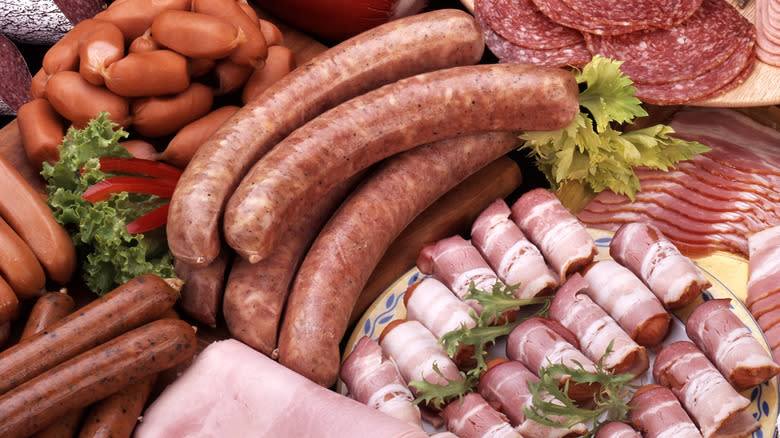
We all know that bacon and sausage are two completely different things. One is the delicious, crispy, red-brown star of a BLT sandwich, and the other is a delicious tube of meat you can enjoy in a bun or scrambled up on top of pizza. But you might be surprised to learn that these two meats have more in common than one might think.
They're both red meats, for one thing, and they're both essential parts of a big, hearty, savory breakfast. Sausage and bacon are even eaten together in many dishes, like casseroles, biscuit sandwiches, and on pizza. They're both in the same category of meats (the processed kind). And, let's be honest, they're both just plain good.
In this article, we're going to tell you everything you ever wanted to know about both sausage and bacon. We compare and contrast the two meats, to highlight their unique attributes. Armed with knowledge, you can decide which one would make the best addition to your meal (or you can add both if you want -- we won't judge!).
Read more: 11 Things You Didn't Know You Should Be Doing With Bacon
What Is Bacon?
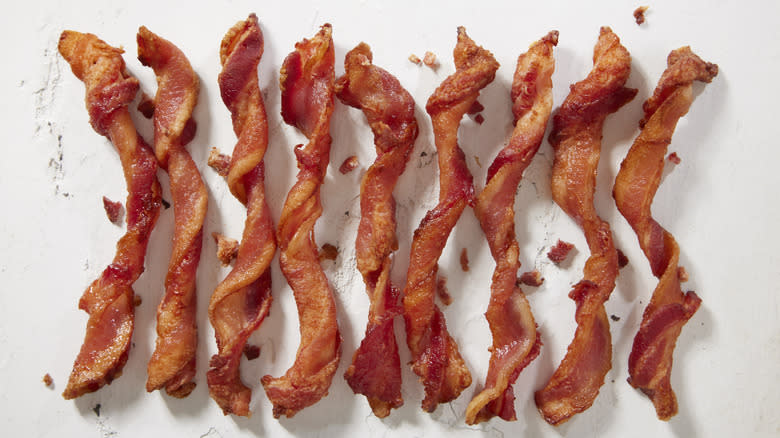
We're going to go out on a limb here and assume that you have eaten, or at least seen, a slice of bacon before. You know what it looks like and probably what it tastes like, but what exactly is bacon?
To put it simply, most bacon is a particularly fatty meat taken from the side of a pig. The ribs are removed and the meat is cured and smoked, which is what gives bacon that delightful flavor. Canadian bacon, however, is taken from the much leaner loin of the pig, which gives it a slightly different texture and flavor. In the U.S., bacon comes in five main forms: Slab bacon, which comes from the belly of a pig or hog and has undergone the curing process for around two weeks; thin sliced; thick sliced; regular sliced, which is cut from slab bacon; and "ends and pieces," which are the parts left over after the slices are made. They are the same thing as slab and sliced bacon, but they come in chunks and bits instead of slices, and can be used to flavor things like green beans.
Historically, bacon was especially popular among peasants in western Europe. It spread into the rest of the world thanks to its long storage life, a result of the curing process. It didn't always look like it does now, though -- standardizing the cuts took a few centuries.
What Is Sausage?
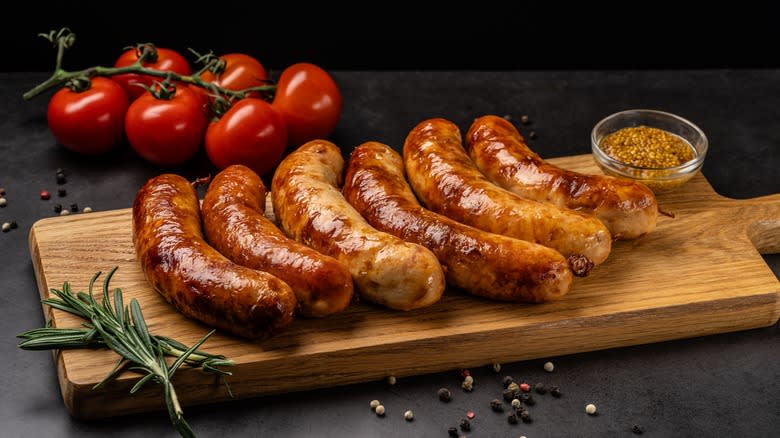
Ever hear the phrase "don't ask how the sausage gets made?" It's often used to warn people not to ask questions they don't really want the answers to. But we're going to tell you the literal answer to this question anyway -- in the least-gross way possible, of course.
For starters, sausage is not technically a "meat" in and of itself -- it is a "meat product." This is because it's composed of many other pieces of meat that have been seasoned, chopped and/or ground up and stuffed into an edible casing made from the intestines of various animals, or from collagen, a man-made creation formed with animal protein (whew, okay, now the gross part is over). There are also alternative casings that are made from plastic (which have to be removed before eating), as well as skinless sausages, which are made with a cellulose casing that is removed during later stages of production.
In modern times, machines push the meat and other fixings into the casing. But this food has been around since long before such technology existed. In fact, sausages of various kinds have existed since ancient times in Greece, Rome, and Babylonia. Various Native American cultures also had versions of sausages made from berries and dried meats. Another surprising fact? Bologna, frankfurters, and salami are all considered to be sausages, and have been around since the Middle Ages.
Both Sausage And Bacon Are Popular Breakfast Choices
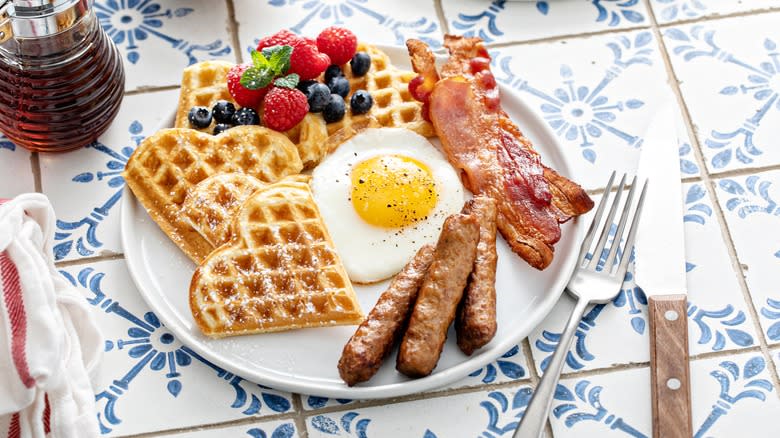
While it's common to see sausage on a pizza and bacon on a burger, the meal where both of these meats (or "meat products") really shine is breakfast. Both are particularly beloved in the American South, where a big Sunday breakfast of bacon, eggs, sausage, and gravy is seen as the perfect start to the day. While some people may prefer a sweeter, easier-on-the-stomach breakfast like pancakes or toast, the massive popularity of sausage and bacon can't be denied. This is evidenced by the fact that fast food restaurants like McDonald's and Burger King have entire breakfast menus dedicated to sandwiches that feature sausage and/or bacon on a biscuit instead of a bun.
Sausage and bacon both work very well with eggs, and are often served either beside them on a plate, together with them in a sandwich, or combined with them in a casserole. These casseroles can be eaten at any time of day, and are especially enjoyable with the addition of cheese. You can even add ham, if you want even more meaty goodness.
Bacon Is (Usually) A Cured Meat
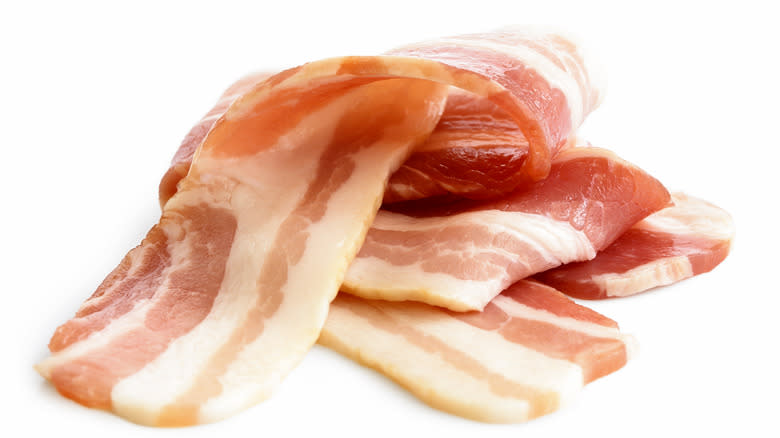
Bacon gets its smoky flavor and long shelf life from the curing process. Curing is a method used to make food last longer, and is usually accomplished by applying copious amounts of salt to the meat. This staves off bacteria by drawing the moisture out. However, the process of curing is not always so cut and dry. The curing of bacon also involves nitrates and nitrites, which help kill bacteria and give the meat its trademark crimson color. These nitrates and nitrites have caused a division among bacon lovers because they can cause nitrosamines, which are believed to be carcinogens, to develop when the bacon is cooked at an elevated temperature -- which is basically always.
Because of some consumers' reluctance to eat food that could potentially be harmful, two types of bacon have been developed: "cured" and "uncured." But things get a little complicated at this point. According to The Washington Post, many types of "uncured bacon" are actually still cured. "Uncured" bacon which resembles typical bacon is cured using nitrite created from vegetables like beets or celery instead of man-made products. But they still contain nitrites, and they are still cured. This is definitely something to keep in mind when you are choosing a bacon product.
Both Bacon And Sausage Are Processed Meats
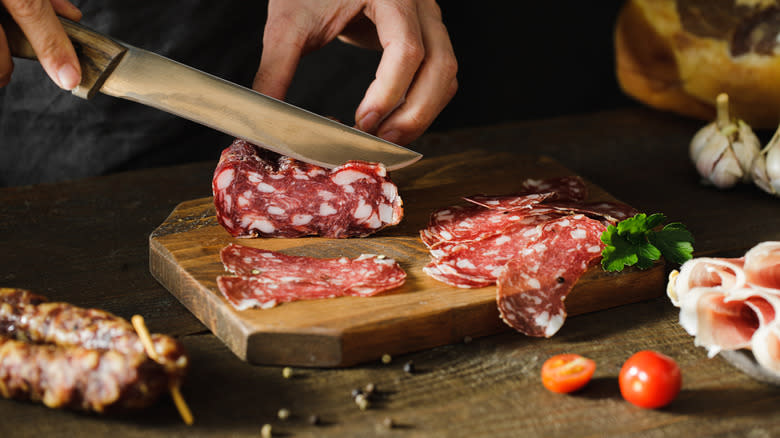
Both bacon and sausage are red meats. According to the World Health Organization's International Agency for Research on Cancer, "The consumption of red meat [is] probably carcinogenic to humans." Things get even worse for both meats when you factor in their classifications as processed meat, which is classified by the WHO as "carcinogenic to humans," period.
According to Lindsey Wohlford, a dietitian at MD Anderson Cancer Center, "Eating processed meats like bacon and cold cuts can increase your chances for stomach and colorectal cancer." Some other examples of processed meats are hot dogs, pepperoni, beef jerky, deli meats, ham, and, of course, sausage.
Processed meats have undergone a process (thus the name) to preserve them. These processes can include curing, as in the case with bacon, smoking, salting, or using chemical preservatives. While scientists are not yet completely certain that these meats cause cancer, the nitrates and nitrites used to cure meats like bacon have been linked to the illness. So has the process of cooking these meats at high temperatures, due to the heterocyclic amines and polycyclic amines it creates.
So, what's a meat eater to do? Do you have to give up bacon and sausage entirely? Well, you can -- or you can just be sure to eat them sparingly.
The Many Different Kinds Of Sausages
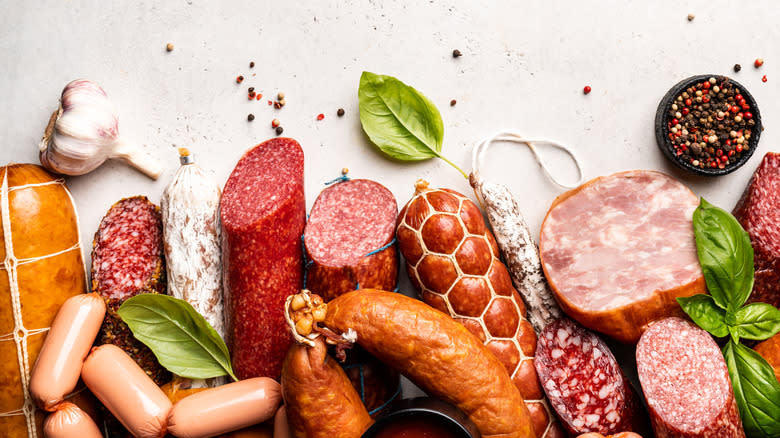
Unlike bacon, there are an infinite amount of sausage variations. First, you have ready-to-eat sausages, which are cooked, dried, or semi-dry, and are safe to go ahead and chow down on as soon as you open the package. Within that category, dry sausages can be broken down even further into cooked, smoked, or unsmoked sausages. Ready-to-eat sausages include bologna, frankfurters, and salami.
The second main type of sausage is uncooked. These come in patties, links, or in a package in bulk, in which case you can shape or scramble the sausage as you please. Smoked sausage is also classified as an uncooked sausage. Both cooked and uncooked sausages can contain a wide variety of meats in their casings, ranging from ground beef, pork, veal, lamb, chicken, turkey, or a combination of two or more of these. Often, herbs and spices are included in the sausages to make them even tastier. To make a long story short, if you can grind it up finely and stuff it into a casing, you can make a sausage out of it.
Both Have A Turkey Option
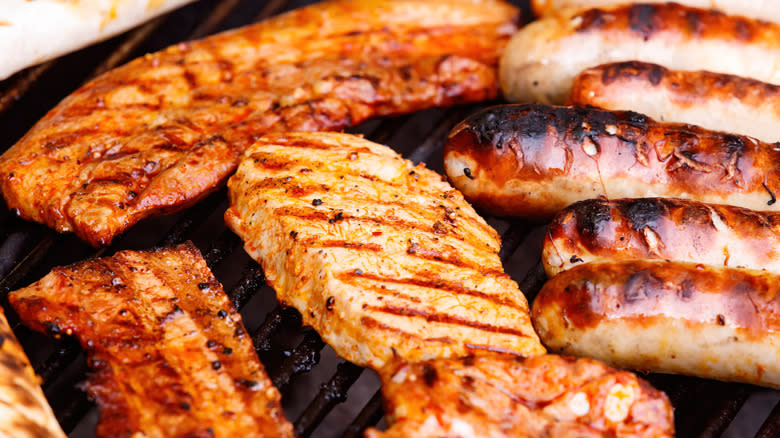
One unique thing that bacon and sausage have in common is that they both come in a turkey version. These are a good option for those who can't eat pork due to religious or dietary reasons. Turkey bacon is described by the USDA as "a cured, bacon-like product." Because the definition of bacon is a cured meat that is created from pork, it can only be "bacon-like." However, turkey bacon must still adhere to the same rules and requirements as pork bacon, one of which stipulates that the type of meat used to make it much appear clearly on the package. Bacon made from poultry is usually already cooked when you buy it, but it can still be cooked like ordinary bacon to make it crispy.
Turkey sausage, on the other hand, is made much the same way as regular sausage. It is thought to have less fat because it comes from leaner poultry meat instead of pork or beef. Both are made with similar seasonings, though regular sausage typically has higher amounts of additives, like sodium.
Sausage Cooking Instructions Vary
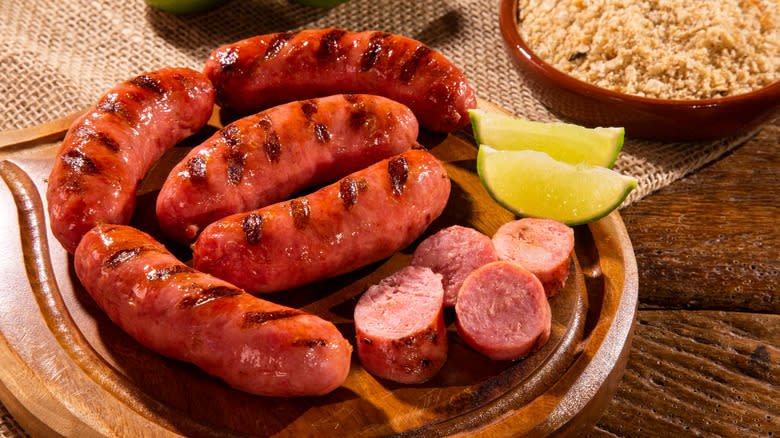
Now that we know all about what sausage is and what it's made of, we get to the good part: How to cook it and eat it. Starting with the practical side of things, it's necessary to remember that the cooking time for sausage depends on what's inside the sausage. If it's made from beef, lamb, pork, or veal, the USDA's guidelines state that it needs to be cooked until it reaches at least 160 degrees Fahrenheit. If it contains poultry products like chicken or turkey, it should be cooked a bit longer, until it reaches 165 degrees.
Now for the fun side of things. Since you know how to safely cook sausage, you need some recipe ideas! You can roast sausage with onions, you can grill it on a hot day, you can saute it with peppers, you can make sausage and gravy, you can make pasta with sausage ragù, you can make sausage quiche, or you can even make jambalaya with Andouille sausage and shrimp. And that's just the tip of the iceberg. Since there are so many different types of sausage that go great with so many things, there are more sausage recipes out there than you could ever imagine. So you'd better start cooking! (Or, well, maybe wait until you finish reading this article.)
Bacon Should Look Crisp When Cooked

Unlike sausage, bacon is too thin to have a recommended safe cooking temperature. Even the thick sliced type of bacon is too thin for a meat thermometer to get an accurate reading from. Thus, the USDA recommends cooking your bacon until it is crisp. Once it has reached this stage, it's safe to say it's thoroughly cooked, even if it may remain a pinkish color due to the chemicals used in the curing process.
So now that you know how to cook it, what can you do with all that lovely bacon? Well, you can go with a classic BLT (bacon, lettuce, and tomato sandwich), or you can branch out and add crumbled bacon to salads or pastas. You can also wrap it around hot dogs or sausages for a new take on pigs in a blanket, or use it as part of a stuffing for filled biscuits or rolls. You can also add it to soups, casseroles, frittatas, and even add the ends and pieces to baked beans too.
Uncooked Sausage And Raw Bacon Should Be Refrigerated
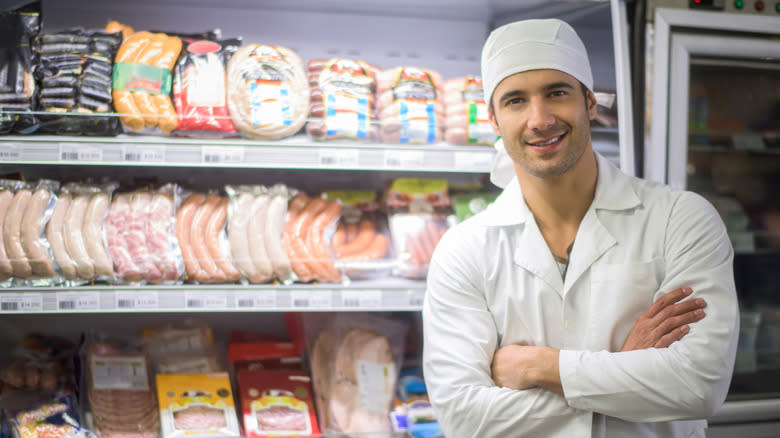
If you want to enjoy your sausage and bacon without running the risk of getting a food-borne illness, you need to know how to store it properly. In most cases, this means in the refrigerator. Fresh, uncooked sausage should be stored in the refrigerator for one or two days, whether it's opened or not. After it's cooked, it can stay in the fridge for three to four more days. Pre-cooked sausages like hot dogs can be kept refrigerated for two weeks, but just for one week after you open the package. Unopened lunch meat can stay in the fridge for two weeks, and for three to five days after the package has been opened. Semi-dry summer sausage can last a whopping three months in the fridge, but should be kept there no longer than three weeks after opening.
Beef bacon, poultry bacon, and pancetta stay good for one week in the fridge and should never be stored in the pantry. Dry-cured sliced bacon can stay at room temperature for around 10 days if it's unopened, but can last around a month in the refrigerator. Bacon cured without nitrites should go in the fridge as well, and will be good for up to three weeks. Leftover cooked bacon of any kind can be kept there for four to five days.
Read the original article on Daily Meal.

